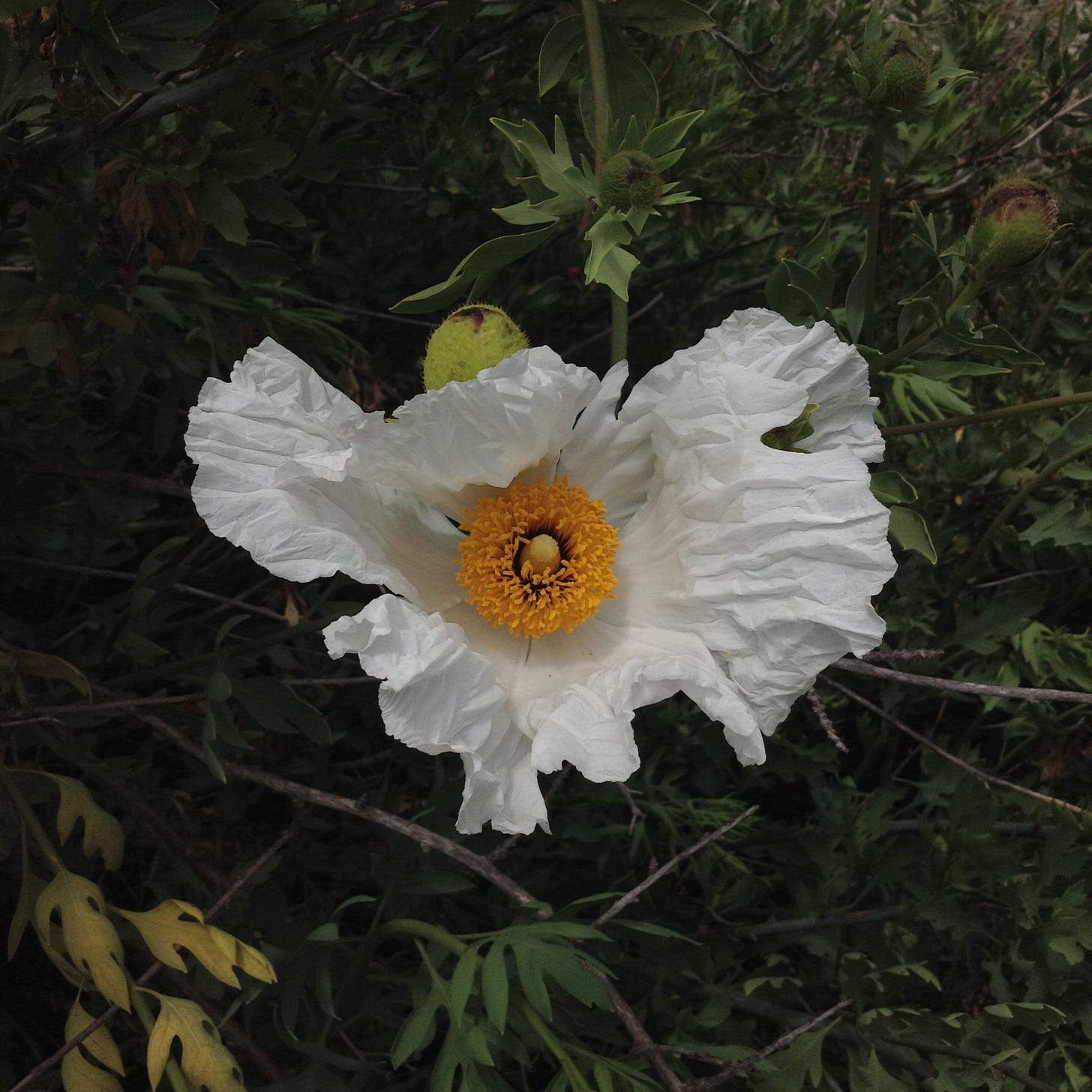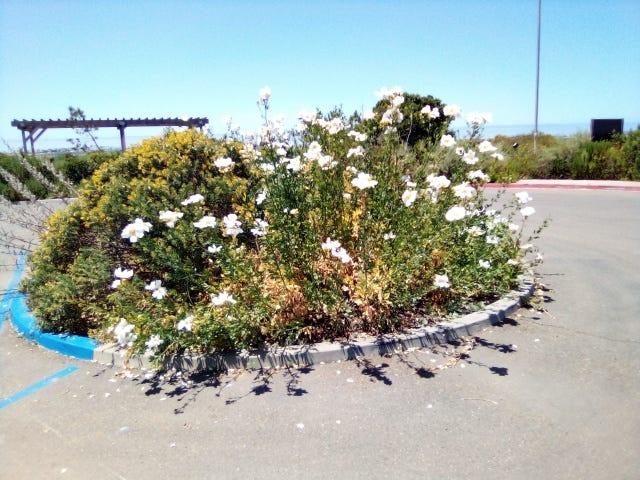In touch: Matilija poppy
Adapted to living with fire, this poppy's beauty may save it from extinction, but there may be a twist
As just about the whole world knows, California has been experiencing one of the most dramatic superblooms we’ve had in recent years. great swaths of yellow, blue, and magenta have painted hillsides and valleys. Closer to where I live, in San Diego, our native, open spaces are filled with the colors of spring flowers as I haven’t seen in years. An outing to Torrey Pines State Reserve this week revealed brilliant reds of monkeyflowers, bright yellows of suncups, and the creamy lavender of snapdragons.
Flowers are blooming at the zoo where I work, too, including the flamboyant Matilija poppies. Matilija poppies are big and dramatic. Their flowers measure about six inches across, with huge, pure white crinkly petals encircling deep yellow stamens and pistils.
The Matilija poppies’ astounding beauty came close to enshrining them as the state flower of California, but that honor went to the California poppy. Matilija poppies grow only in a limited range of southern California, and maybe folks wanted a flower that grew throughout the state, as does the California poppy. (Never mind that the state animal, the grizzly bear, doesn’t live anywhere in the state anymore, but that’s another matter.)
As lovely as the poppies are, they spread aggressively by runners and can take over other plants, so I have them isolated at the zoo in two large planters surrounded by tarmack and concrete. Gardening websites say the poppies are deciduous, but the ones at the zoo seem to stay green all year long. I have to cut them back from time to time, but otherwise they need little care.
The poppies are big and lovely; they are also rare
The Matilija poppy is fairly rare. The California Native Plant Society gives the poppy a rare plant ranking of 4.2, which means that it has “limited distribution” and is “fairly threatened in California.”
All plants of the chaparral and coastal sage scrub—the plant communities that dominate most of southern California—are adapted to surviving the periodic fires that have been part of this region for tens of thousands of years. Some plants resprout from underground burls after a fire. Other plants, including the matilija poppy, have seeds that germinate only after exposure to fire. It’s uncertain what stimulates the poppy seeds to germinate, whether it’s the heat of the fire or the chemicals in ash or smoke or some combination, but fire is the key to germination.
Unlike the western forests, which commonly experience lightning strikes that ignite ground fires around every seven years, chaparral and coastal sage have historically burned in intervals of 20 to 120 years, sometimes even longer. These plant communities burn in crown fires, which consumes all vegetation.
During the decades between fires, the seeds of the Matilija poppy build up in the soil, creating a seed bank. The seeds lie dormant for 20, 30, 40, 60 years or longer before they might be germinated. Because humans have barbecues, cigarettes, power lines, and other sources of ignition, major fires now occur more often, with only ten or fewer years in between. This isn’t enough time to build up enough seeds to ensure that a good number of poppies will germinate after the next fire. Over time, fewer and fewer poppies sprout.
We have also reduced a great extent of the Matilija poppy’s natural range. Calscape is an online database of California native plants; their map of the poppy’s range shows its occurrence in the preserved open spaces of Marine Corps Base Camp Pendleton, yet the plant is excluded from the sprawling cityscapes of Oceanside and Carlsbad to the south and Huntington Beach, Long Beach, and Los Angeles to the north. From this information, my guess is that much of the Matilija poppy’s natural range has been paved over.
It is frustrating to talk to folks about saving a rare desert buckwheat or a salamander that lives in the upper branches of a remote Appalachian stream. Their eyes glaze over, and I can tell that most of them would rather have their spleens removed than hear any more about saving a rare and not necessarily appealing species.
But folks seem to care more when it comes to the fate of grand California condors, redwood trees, and other species that are beautiful, majestic, cute, or somehow appealing. As such, the beauty of the poppy may prove to be a key to its survival. But there is a twist….
Folks love the Matilija poppy all over the world
Many California gardeners and native plant enthusiasts love to include the Matilija poppy as part of their landscaping. Close to 70 nurseries in California sell the plant or its seeds. What’s more, in researching this Substack post, I found places in North Carolina and Great Britain where Matilija poppies can be purchased or provide recommendations on their planting and care.
Because we continue to sprawl throughout southern California, transforming hillsides and valleys of chaparral and coastal sage scrub into houses, streets, and parking lots, and because we continue to ignite the chaparral and other landscapes, and global heating makes those fires larger and more common, it is easy to imagine the Matilija poppy growing ever more scarce in its native home, its wondrous beauty unable to stem the onslaught of development and our carelessness. Yet I can see the plant becoming a “captured cultivar,” a plant that is endangered or extinct in the wild but kept alive beautifying our gardens and parks in California, North Carolina, England, Japan, New Zealand, Argentina, and any other place where people appreciate this beautiful poppy.
I like the idea of the poppy continuing to live, but it disturbs me to think that it may be extirpated from its natural habitat. What about you? What do you think of the Matilija poppy’s future?








Beautiful! I love the Matilija poppy, and yes, it's somewhat overtaking my garden... I have a new garden in a different spot and just planted one there too. I hope I don't regret it. Thank you for this post. I value your contribution!
I realize it won't help to keep the Matilija poppy truly wild, but do you think I can grow them in a drip-irrigated garden in the Coachella Valley? On Calscape, they do not appear east of the San Bernardino mountains.